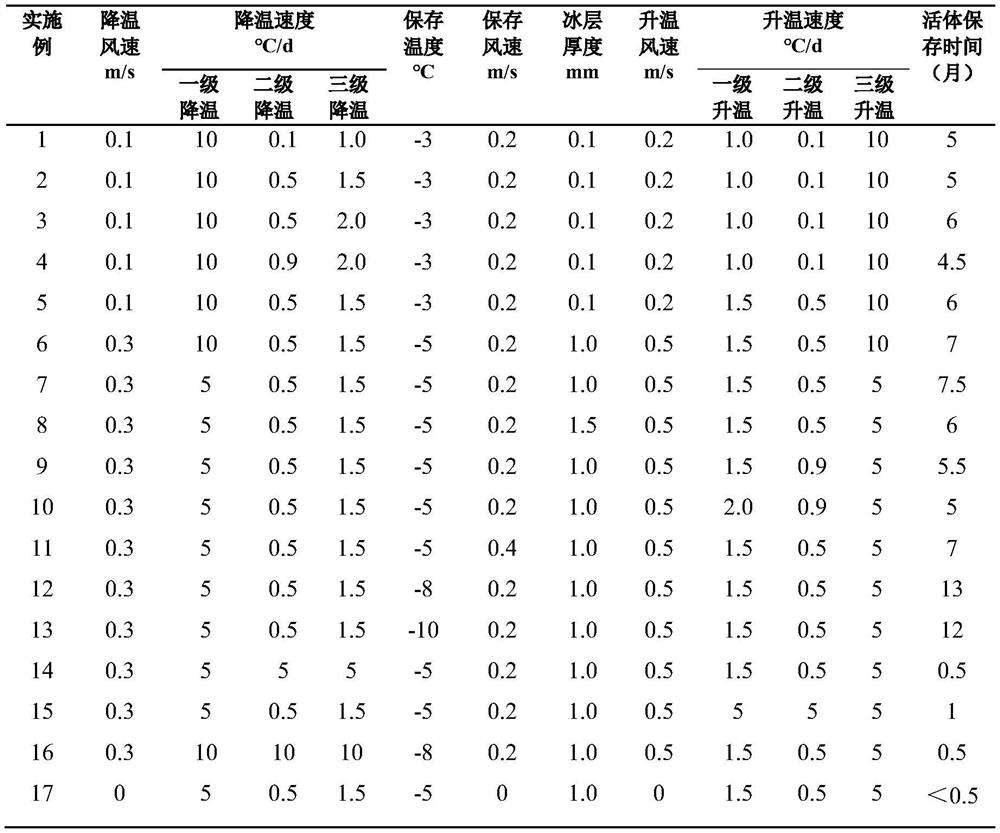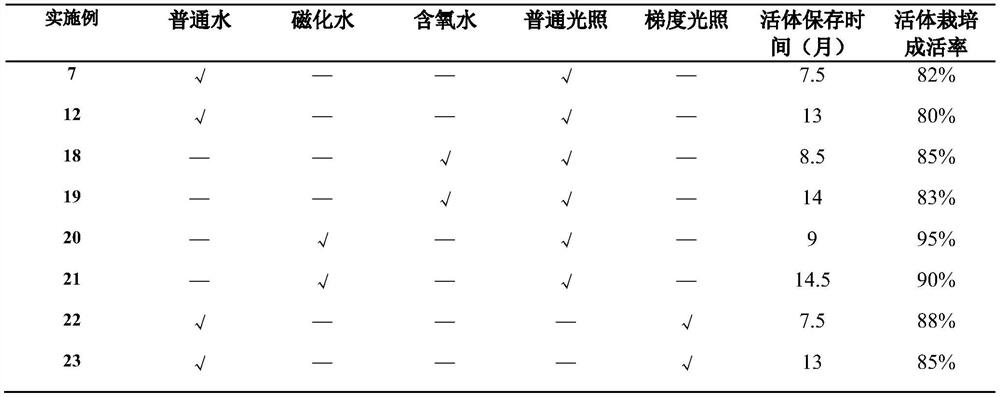A kind of cryogenic freezing living body preservation method
A low-temperature freezing, living technology, applied in the fields of botanical equipment and methods, plant preservation, seed and rhizome treatment, etc., can solve the problems of plant rhizomes still living, plant cell structure damage, plant wilting, etc., and is conducive to quality preservation. and preservation of viability, protection from loss of viability, and avoidance of plant decay
- Summary
- Abstract
- Description
- Claims
- Application Information
AI Technical Summary
Problems solved by technology
Method used
Image
Examples
Embodiment 1
[0026] A low-temperature freezing living body preservation method is characterized in that it comprises the following steps:
[0027] A. Material pretreatment: remove the soil and sundries on the surface of the chicory root;
[0028] B. Cooling and dehydration treatment: keep the ventilation speed at 0.1m / s, carry out gradient cooling treatment on the chicory root in step A, first drop from room temperature to 5°C at a cooling rate of 10°C / d, and then drop to 5°C at a cooling rate of 0.1°C / d The cooling rate is reduced from 5°C to 0°C, and then from 0°C to -3°C at a cooling rate of 1.0°C / d to obtain low-temperature dehydrated chicory roots;
[0029] C. Spray and ventilate storage: keep the low-temperature dehydrated chicory root in step B at a constant temperature of -3°C, and provide air to the low-temperature dehydrated chicory root with an air velocity of 0.2m / s, and spray water mist on it once every three days, and Forming a 0.1mm-thick heat-retaining ice layer on its sur...
Embodiment 2
[0032] A low-temperature freezing living body preservation method is characterized in that it comprises the following steps:
[0033] A, material pretreatment: remove the soil on the surface of the chicory root, and remove the yellow leaves;
[0034] B. Cooling and dehydration treatment: keep the ventilation speed at 0.1m / s, carry out gradient cooling treatment on the chicory root in step A, first drop from room temperature to 5°C at a cooling rate of 10°C / d, and then drop to 5°C at a cooling rate of 0.5°C / d The cooling rate is reduced from 5°C to 0°C, and then from 0°C to -3°C at a cooling rate of 1.5°C / d to obtain low-temperature dehydrated chicory roots;
[0035] C. Spray and ventilate storage: keep the low-temperature dehydrated chicory root in step B at a constant temperature of -3°C, and provide air to the low-temperature dehydrated chicory root with an air velocity of 0.2m / s, and spray water mist on it once every three days, and Forming a 0.1mm-thick heat-retaining ice...
Embodiment 3
[0038] A low-temperature freezing living body preservation method is characterized in that it comprises the following steps:
[0039] A. Material pretreatment: remove the soil and sundries on the surface of the chicory root;
[0040]B. Cooling and dehydration treatment: keep the ventilation speed at 0.1m / s, carry out gradient cooling treatment on the chicory root in step A, first drop from room temperature to 5°C at a cooling rate of 10°C / d, and then drop to 5°C at a cooling rate of 0.5°C / d The cooling rate is reduced from 5°C to 0°C, and then from 0°C to -3°C at a cooling rate of 2.0°C / d to obtain low-temperature dehydrated chicory roots;
[0041] C. Spray and ventilate storage: keep the low-temperature dehydrated chicory root in step B at a constant temperature of -3°C, and provide air to the low-temperature dehydrated chicory root with an air velocity of 0.2m / s, and spray water mist on it once every three days, and Forming a 0.1mm-thick heat-retaining ice layer on its surf...
PUM
 Login to View More
Login to View More Abstract
Description
Claims
Application Information
 Login to View More
Login to View More - R&D
- Intellectual Property
- Life Sciences
- Materials
- Tech Scout
- Unparalleled Data Quality
- Higher Quality Content
- 60% Fewer Hallucinations
Browse by: Latest US Patents, China's latest patents, Technical Efficacy Thesaurus, Application Domain, Technology Topic, Popular Technical Reports.
© 2025 PatSnap. All rights reserved.Legal|Privacy policy|Modern Slavery Act Transparency Statement|Sitemap|About US| Contact US: help@patsnap.com


